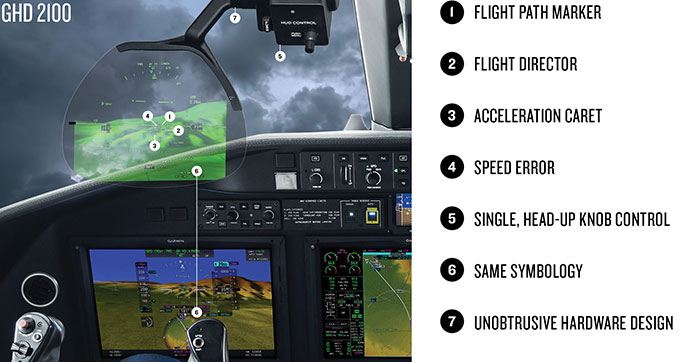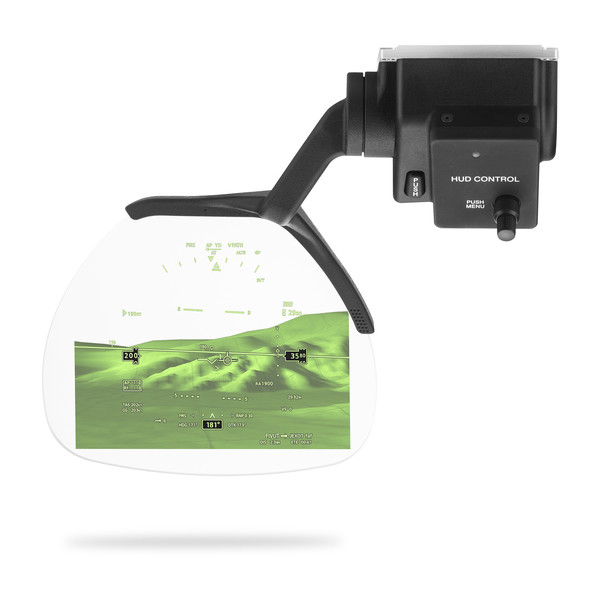GHD™ 2100 Head-Up Display
Eyes-forward Flight Technology Takes a Major Leap Forward
- Intuitive Head-Up Display (HUD) optics with synthetic vision imagery and other advanced cues put key flight information in the pilot’s forward field of view — enhancing safety and situational awareness
- Consistent symbology with our integrated flight deck systems provides a virtually seamless viewing transition between cockpit displays and matching HUD information
- System consists of a high-resolution glass combiner display and a slim, self-contained projection unit designed to give pilots more cockpit headroom
- Flight path marker-based flight director cues and other advanced cues show exactly where the aircraft is going in relation to the intended flight path, enabling smoother, more precise control corrections, intercepts and approaches
- Allows operators to pursue Special Authorization Category I (CAT 1) or Category II (CAT 2) approvals for instrument landing system (ILS) approach minima

Designed to integrate seamlessly with our integrated flight deck systems for light- to super-midsize business aircraft, GHD 2100 HUD gives pilots a fully integrated “out-the-window” view of their primary flight display (PFD) information, overlaid with a synthetic vision virtual perspective. HUD technology allows pilots to fly more “eyes out” — and less “head down” — to maintain optimal situational awareness throughout every phase of flight.
Safety-enhancing Visual Interface
Especially useful during critical takeoff and approach transitions, the HUD provides pilots with a forward-looking reference that’s consistent with the symbology and information presented on our glass cockpit flight displays. So, visual transition between displays is virtually seamless. In addition to displaying flight-critical PFD information, GHD 2100 overlays the real-world view through the glass HUD with conformal attitude and flight path information alongside navigation data, flight plan information, autopilot modes, master warning/caution annunciations and more. Garmin SVT™ synthetic vision technology uses sophisticated graphics modeling to create a 3-D “augmented reality” view with terrain, obstacles, runways and other details similar to those displayed on our integrated flight deck PFDs. And because the synthetic vision image replicates what’s visible through the aircraft windscreen on a clear day, a smooth transition from cockpit displays to outside visual reference is virtually assured. Industry studies have shown that flying with HUD technology offers significant safety-of-flight advantages in marginal or deteriorating weather conditions with reduced visibilities and other environmental challenges.

Headroom-saving Form Factor
The GHD 2100 system consists of an optical-grade, high-resolution glass combiner display and a slim-profile digital projection unit. The space-saving design of the HUD projection unit makes it a good fit for business aircraft-sized cockpits. Aligned at eye level between the pilot and the windshield, the transparent combiner display provides a 30 degree wide by 24 degree vertical field of view with superior brightness and clarity in all lighting conditions. “Intelligent dimming” technology automatically adapts the display to ambient light levels, enabling pilots to focus on flying the aircraft instead of fiddling with lighting controls. To further reduce pilot workload, GHD 2100 offers a declutter mode, so pilots can optimize the display to fit their preferences and flight data priorities. Upon entering approach mode, the HUD display can automatically declutter to help pilots more easily identify the runway environment and approach-related navaids or waypoints.
SurfaceWatch™ Runway Monitoring
Adding to the safety-oriented features provided by GHD 2100, our SurfaceWatch technology offers pilots visual and aural clues that can help prevent runway incursions or other operational miscues such as takeoffs or landings on a taxiway — or on a runway that is too short — or on the wrong runway based on performance data entered during preflight. For example, while on approach to a snow-covered runway or in an airport environment with reduced visibility conditions, SurfaceWatch highlights and outlines the pilot-selected runway on the HUD and on the PFD, so it’s easier to identify.
Precision Flight Path Guidance
To help pilots fly precisely, indications showing the aircraft’s projected path — compared with desired track, speeds and more — are presented in a consolidated, easy-to-scan area. This graphical display shows the calculated effect of variables, such as crosswind, angle of attack, airspeed and more, on the aircraft’s trajectory across the ground. For easy interpretation, all of this information is centered around the flight path marker-based flight director, which indicates the aircraft’s projected trajectory compared to the desired track. Additional features, such as speed offset and velocity cues, further enhance dynamic management of the aircraft by comparing actual versus targeted FMS data. It’s a valuable tool to have when trying to gauge a possible conflict with terrain or obstacles near the flight path. And it’s also very useful in targeting the runway threshold on approach, particularly when correcting for crosswinds or low-level turbulence.
Adding Value to Visibility
It’s easy to see how GHD 2100 brings added safety and situational awareness to the cockpit. But more than that, it also adds operational capability that enables approaches to lower minimums — helping pilots avoid costly and time-consuming missed approach procedures and resulting in fewer diversions to alternate airports. With GHD 2100, operators can pursue Special Authorization Category I (CAT 1) or Category II (CAT 2) approvals for U.S. ILS approach minima.
Look Forward with Confidence
Designed with built-in growth provisions to accommodate future options such as external video cameras, multispectral enhanced vision systems (EVS) and more, the GHD 2100 system offers a clear path to ongoing developments in HUD technology. For Garmin, it seems, a forward-looking vision is what HUD systems are all about.

